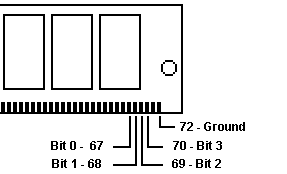|
Memory Presence Detect
72 pin SIMM Identification with a DMM
Resistor to PD Bit
SIMMulator (Socketed
PD Tester, cheap!)
The presence-detect signals are used by the system to determine the
size and speed of memory on the memory module. The pins are either not
connected (1) or connected to ground (0).
72 pin SIMM Identification
when no Shunts Are Visible
From the PC and PS/2 Pocket Reference Manual, Feb 1996-
The presence detect pins 67-70 tell the system the size and
speed of the IBM standard 72 pin parity SIMMs. Using good ESD proceedures
and a digital Volt/ohm meter, measure the resistance between pins 67-70
and 72 which is ground. (R1, R2, etc)
Mem Presence for College Graduates

Don't even THINK. Just DO. Set DMM on lowest range for
continuity (mine was 300mV) and touch pin 72 and sweep the others. Lay
the SIMM down so it resembles the illustration. Look at my ASCII stuff
below. Match like to like. "o" is open, "*" is a beep (if you have a continuity
function, zero ohms if you don't).
100ns
85nS 80nS
70nS
1MB * o * * * o o *
2MB o * * * o * o * o
* * o * * o o
4MB
* * * * * * o *
8MB
* * * o o o * o
Notes:
If the PD Shunts are Visible
A set of four bits shows the state of the presence-detect signals for
a specific memory connector; a bit is 0 when the signal is connected to
ground by the memory module.
Thanks Peter!
Presence Detect Signals
ECC/PAR (Pin 48)
-------------------------- -+
PD Bit0 (Pin 67)
------------------+
|
PD Bit1 (Pin 68)
----------------+ |
|
PD Bit2 (Pin 69)
--------------+ | |
|
PD Bit3 (Pin 70)
------------+ | | |
|
GND (Pin 72)
--------+ | | | |
|
| | | | |
|
V V V V V
V
+------------------------- --- ---------+
| # # # # # # # # #.. #
.. # # # |
| # # # # # # # # #
# # # # |
|
|
| 7 7 7 6 6 6 6 6 6
4 0 0 0 +-+
| 2 1 0 9 8 7 6 5 4
8 3 2 1 |
Geek Speak
I am a college gradidiot. So for all of us common sense deprived
individuals
PD Bit 0 1
2 3
Resistor R1 R2 R3 R4
SIMM Pin 67 68 69 70
SIMMulator
Jim Shorney sez:
Whacked the end SIMM socket off of an old Dell motherboard
with a hacksaw and soldered up four LED's with 1K current limiting resistors
to pins 67-70. Feed it 9 to 12 volts DC against pin 72, and it makes
a nice PD code reader for aSIMMilating those unidentified memory modules
into the proper baggie. No more fumbling with an ohmmeter.
Tony I has a safety announcement:
Sacrifice a clone mobo for the socket. A propane
torch from the rear will usually drop'em off pretty clean. Gotta
burn through the little attach
pegs, but once that's done they drop right off...
A pail of water is nice to have standing by. Sometimes
the boards light up pretty good and really start stinking and billowing
clouds of black smoke. Don't want the neighbors to call the FD ;->
9595 Main
Page
|
